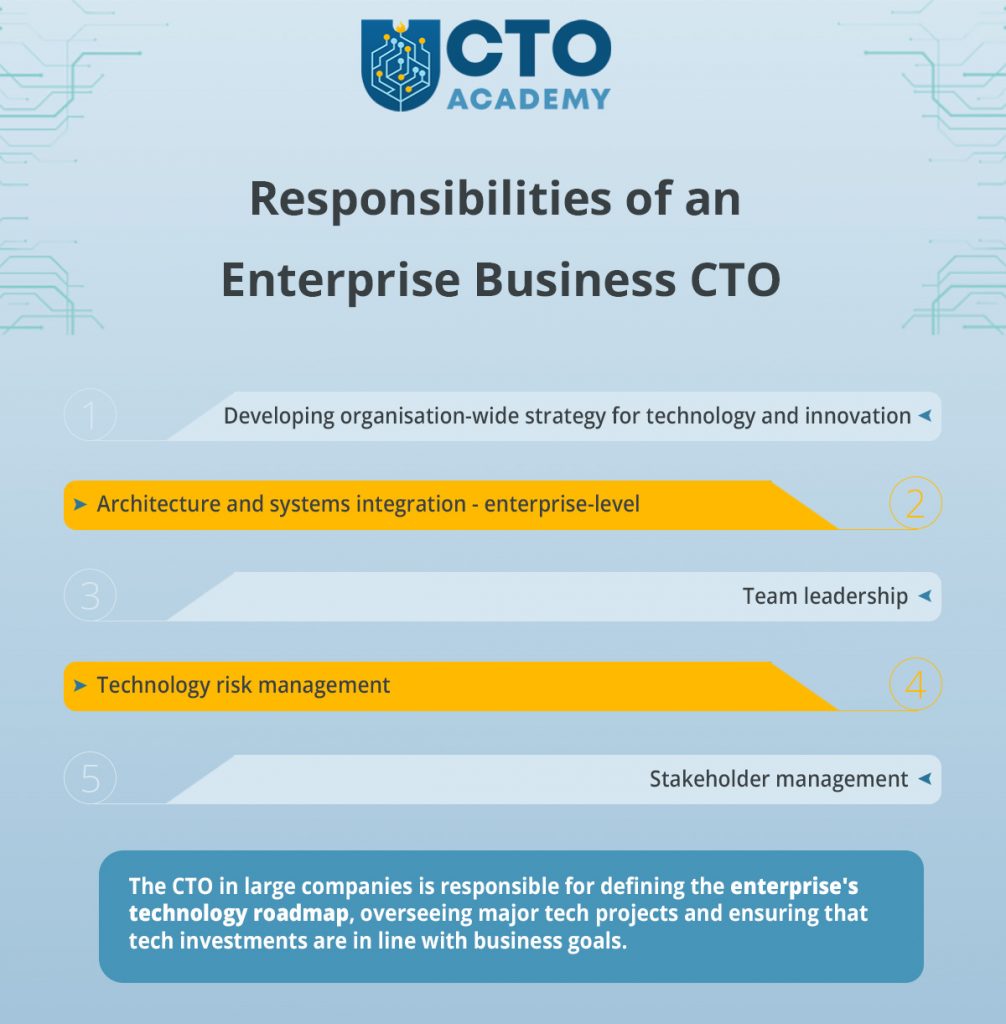In this post, we explain a CTO job description on four levels of engagement: start-up, fast-growth company, enterprise and, finally, a Group Chief Technology Officer. You will learn responsibilities on each level, understand desired qualifications and, ultimately, find out what kind of salary you can expect considering the size of your company and industry.
TABLE OF CONTENTS
There are universal job responsibilities for Chief Technology Officers that simply scale up or down relative to the business size.
Strategic technology planning
Communication of tech vision
Innovation and research
Managing development processes
Infrastructure management
Growth risk management
Talent acquisition and development
Stakeholder collaboration
Vendor and partnership management
Monitoring industry and market trends
When we consider stages of development, we can then see some distinct differences in daily duties and responsibilities between a startup CTO and, for instance, technology leaders in fast-growth companies.

The Chief Technology Officer in start-up companies typically focuses on the early-stage strategic and technical aspects of technology. Their role involves overseeing the development and implementation of technology solutions aligned with the company’s goals.
It’s worth mentioning that the responsibilities of a Chief Technology Officer in a start-up may vary based on its scale, configuration and field. Nevertheless, generally speaking, a CTO is highly involved in the process, donning several hats and working closely with frontline team leaders and project managers to devise technology strategies that match the company’s needs.
Technology strategy development and implementation
This means that CTOs must have a thorough understanding of the company’s current and future technology needs to create and implement a technology roadmap that aligns with the business strategy.
Technology projects management
The Chief Technology Officer manages the technology team to guarantee timely, budget-friendly and quality project delivery.
Steering clear of the critical path
Start-up CTOs often remain involved in development. They must avoid being in the critical path to have time for other responsibilities.
Keeping abreast of emerging technologies and competitors
Start-ups in competitive markets require CTOs to stay updated on emerging technologies and their potential impact.

The job description expands and now includes a combination of operational and strategic elements. Job requirements become more complex as the needs and challenges of the organisation constantly evolve.
Technology leadership in fast-growth businesses involves, among other things:
Developing and executing technology strategy
This technology roadmap must align with the long-term company’s business objectives. It ensures that technology investments support the three most important goals: growth, productivity and profitability.
While this was partially on a side plate during the early start-up stage, at this point of the company’s development curve, CTOs must place particular focus on these three goals namely to avoid generating excessive technical debt. Previously, the bulk of funding went directly into product development, especially in a tech startup. The CTO’s key responsibility was to get that MVP and, ultimately, a market-fitted product out asap with little regard toward spending. Now, things are different. Profitability comes first and last. The future progress now predominantly depends on the efficacy of the engineering team. And it’s not just about the output.
Growing and nurturing the engineering team
This is, effectively, a multi-level responsibility. In a nutshell, a tech leader is responsible for recruiting, managing and retaining top technology talent to ensure that the company has the skills it needs to grow. But to do that efficiently, a CTO must create a high-performance culture that fosters creativity, collaboration and continuous learning.
Remember: productivity + profitability = growth. Make no mistake; the CEO will be on your case all the time, pushing the deadlines and asking for the impossible while, at the same time, demanding cost-effectiveness. Only a high-performance culture can deliver on those requests. (Refer to the above link to see how it’s best done.)
But that same team, no matter how productive it is, will always wait for the initiative that comes from the leader. It is basic human nature and the sole reason why we still heavily rely on effective leadership to build virtually anything.
Leading transformative innovation initiatives
One of the key requirements in every CTO job description is identifying new opportunities and developing corresponding innovative solutions that can not only transform the business but keep it ahead of the competition.
That request rests on an advanced technical vision and requires high-level strategic thinking because the CTO is solely responsible for the development of new products, features or services. This implies the implementation of new technologies or processes after leveraging data and analytics to improve both problem-solving skills and decision-making processes.
However, none of the new technologies come without risks and it is the CTO’s job to mitigate them.
Risk management
Technology investments in fast-growing businesses must scale with the increasing demands of the business. To minimise exposure to technology-related risks and, thus, ensure business continuity, CTOs develop structured risk management plans.

The CTO in large companies is responsible for defining the enterprise’s technology roadmap, overseeing major tech projects and ensuring that tech investments are in line with business goals. This is a multifaceted and demanding position that requires managing multiple technology teams while navigating complex business and regulatory landscapes.
Developing an organisation-wide strategy for technology and innovation
As an enterprise CTO, it is important to create and execute a technology plan that supports the overall goals of the entire organisation. This involves recognising new technologies and advancements that can help the business expand and gain a competitive edge on a larger scale, which may not be feasible for smaller or rapidly growing companies.
Architecture and systems integration – enterprise-level
The CTO oversees the design and implementation of the enterprise architecture, ensuring that systems and applications are integrated and optimised for performance and scalability across the entire organisation.
Team leadership
In large enterprises, the CTO is managing and motivating multiple technology teams to deliver on strategic objectives. The primary responsibility is, therefore, to ensure that the teams have the needed resources and support. Enterprise CTOs must also develop talent management strategies to attract, develop and retain top technology talent; only in this instance, on a much greater scale.
Technology risk management
Similar to the previous two development stages, here, we are talking about cybersecurity threats, regulatory compliance, and data privacy. In this instance, however, it requires the development and implementation of robust risk management plans to mitigate potential threats and ensure business continuity.
The major difference and also a challenge is the number and size of the departments. In the start-up stage, there were most likely 2-3 departments and a single team of engineers. It was relatively easy to control activities. Once in a fast-growth stage, these numbers increased a bit, but it was still simple to manage risks and even respond to the threat almost immediately. A large company is a different kind of beast where a threat can creep in through any of the hundreds of backdoors and remain undetected. Managing 250+ employees is just not the same as managing 20 to 50.
Stakeholder management
A large enterprise CTO works closely with senior executives, business leaders of different companies and technology vendors. The job here is to ensure that technology investments support the business objectives.
Lesson “Communicating with all Stakeholders” in Module 1 of the Academy’s Digital MBA for Technology Leaders delivers practical insights, best practices and how-to guides for this vital skill of every successful CTO. Alternatively, refer to this section of the blog post explaining the responsibilities of technology leaders in start-ups and fast-growth companies.
Eventually, if everything goes according to the plan, the organisation will outgrow a single vertical. This is where the Group CTO comes into play.

A Group Chief Technology Officer (GCTO) assumes a more extensive role, primarily focused on coordinating and aligning technology strategies across multiple companies within a corporate group. In essence, this entails overseeing numerous technology leaders, although there are discernible differences.
A Group CTO takes charge of shaping the technological strategies and operations of a cluster of companies or subsidiaries within a larger corporate framework. Consequently, their mandate involves harmonising technology initiatives and strategies across various entities to ensure a cohesive and synergistic approach to technology investments.
In practical terms, this implies that the GCTO must orchestrate technology endeavours and strategies across multiple companies. They are tasked with identifying opportunities for synergy, shared resources and technological collaboration among different business units.
This principle extends to matters of innovation and research and development (R&D). GCTOs often possess a broader perspective on technological innovation that transcends the boundaries of individual companies. In other words, they can guide R&D efforts that wield a cross-company impact.
Now that we know what responsibilities lie ahead, the real question is what exactly are the requirements for this senior executive position? More importantly, how does the hiring process work?
In your opinion, which is more important: technical skills or soft skills?
The truth is, they are equally important and when you check the list of desired qualifications and experience requirements, you’ll understand why.
Let’s start with the usual job interview questions you can expect:
TIP: Address each of these questions in your application, even if they weren’t explicitly asked.
Onboarding is usually a straightforward process that unfolds in six steps:
TIP: Learn how to position yourself to gain a competitive edge and negotiate better compensation terms
Currently, the technology leader in the United States earns approximately $170,000 annually. In the United Kingdom, the corresponding figures differ significantly. In the private sector, the average salary is £96,080, which includes a 12% bonus, while in the public sector, it is £75,950 with a 27.90% pension contribution.
These figures, however, are relative and subject to constant change. They predominantly depend on the a) industry/sector, and b) the size and the development stage of the company.
Becoming a CTO is a multifaceted approach since this role demands a deep understanding of technology trends, strong business acumen and distinctive leadership skills.
Besides a strong educational foundation in computer science, engineering or a related field, gaining hands-on experience in various technical roles is crucial. It’s what gives you the practical knowledge needed to navigate complex technological challenges.
CTOs must also cultivate soft skills, such as communication, strategic thinking and team management. They are, after all, responsible for aligning technology initiatives with organisational goals and leading diverse teams of professionals.
Ultimately, the journey to becoming a CTO involves a combination of education, real-world experience and ongoing self-improvement. It’s a role that demands not only technical expertise but also the ability to innovate, adapt and drive technological excellence.
Academy’s Digital MBA for Technology Leaders presents a certain fast lane to that goal simply because we first built the course our members requested and only then formed the faculty it needed.
It is designed as a blended online learning experience that combines 220 high-impact micro lectures spread across 9 modules, monthly live sessions and, even more importantly, support from the global community of technology leaders.
Once you graduate, your technical capabilities will perfectly align with your newly obtained leadership skills and strong business acumen.
Since its launch in 2022, over 350 existing and future technology leaders from 45 countries joined the course. This is their experience with it.
Alternatively, you might consider opting in for our Membership Program and gain immediate access to:
90 Things You Need To Know To Become an Effective CTO

London
2nd Floor, 20 St Thomas St, SE1 9RS
Copyright © 2024 - CTO Academy Ltd